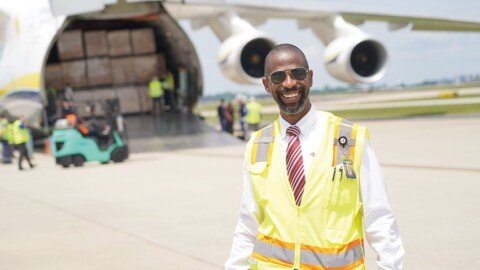The current situation has the importance of cargo capacity crystal clear to operators around the world. Amid the pandemic, while most of its fleet was grounded, Lufthansa was operating multiple cargo-only flights to destinations in Asia and Europe, as were other airlines of the Lufthansa Group. The recent addition of the two converted A321s further means that Lufthansa can offer customers in the e-commerce segment fast intra-European connections. The move is significant for the cargo airline as its freighter focus has been on long-haul routes with B777 and MD-11 aircraft. The decision also highlights the growing demand for e-commerce and comes as airlines find themselves with excess aircraft as a result of the impact of COVID-19 on passenger travel. What’s notable is that the trends continue to shape faster within the world’s leading air freight company. The carrier has just begun offering cargo capacity on Eurowings Discover’s flights, its latest long-haul leisure airline. So, using all of these benchmarks, the airline maintains traction with the best business practices, as well as technologies that result in improved operational effectiveness and efficiency. Ashwin Bhat, Chief Commercial Officer– Products and Sales Division at Lufthansa Cargo in an exclusive conversation with Ritika Arora Bhola, discusses more about their robust set of air service capabilities, helping keep products flowing on time and on demand, and that their future already looks much different from the pre-pandemic landscape.
Having spent over a decade in the air cargo industry, how has your journey been? What major transformations have you observed in the global air cargo sector over time?
From the time I had joined the industry there have been quite a few transformations—from sending messages via telex, using dot matrix printers, using lotus notes as enterprise email to the latest version of outlook and the solutions or software that we use today to conduct our business and transactions. From sending documents across the world via fax machines to using the latest smartphones to scan and share the documents today, from using paper AWBs to eAWBs, there has been a cultural, organisational, and operational change by integrating digital technologies, processes, and competencies across all levels and functions in a staged and strategic way.
Not just technical changes but also the type of services and products that we offer changed towards a globally connected economy, be it pharma or e-commerce.
Transformation can also be observed in the way we work and collaborate due to the changes and requirement from the authorities, whether compliance, security or safety. I am thankful to the various teams, customers, and other partner stakeholders for making my journey enjoyable and successful so far.
Recently coming aboard Lufthansa, how do you look to further strengthen the leading air cargo carrier’s position in the international arena?
As a matter of its ongoing business review, Lufthansa Cargo continuously examines all options for optimising its capacity, service and product offering to its customers. Just for example, by checking new routes and service offers, amongst a host of other possibilities.
In fact, in this regard, Lufthansa Cargo recently decided to expand its cargo capacities by permanently converting two Airbus A321 passenger aircraft
into freighters.
Furthermore, the carrier takes its environmental responsibility very seriously and is currently working on a sustainable product offering to be extended to all its customers.
Eagerly driving digitalisation along the whole transport chain is another important core operational aspect of Lufthansa to improve customer experience and collaboration with each other.
Lufthansa Cargo recently expanded its freighter fleet by adding Boeing 777F aircraft. Do you have plans for more addition in the coming years?
We’re expanding to 15 long-haul freighters and two converted freighters on continental routes across Europe that complement the bellies of our passenger airlines— Lufthansa Airlines, Austrian Airlines, Brussels Airlines, Eurowings Discover, and SunExpress.
Customers for the A321 freighters are expected to include forwarders, integrators and postal operators, as well as e-tailors. The express market is booming; e-commerce is growing at double digits, somewhere around 20 or 30 per cent. But, there is less capacity
in the market and that is where we saw an opportunity. It’s a new area, and we are talking to the whole segment, not just e-tailors.
Lufthansa Group subsidiaries such as heyworld, the cross-border e-commerce platform and express company time:matters, is sure to benefit from the capacity.
Existing belly capacity has not been sufficient for this growing market. It’s only lower deck which runs on passenger schedules. This is a tailor-made solution for the type of businesses that will need it. E-commerce is all about very fast connections and how speedily you can do it. And that’s what we want to do and where we want to achieve growth.
Lufthansa has been steadily meeting the increasing demand of delivering temperature-sensitive products worldwide. At present, how are you gearing up to accomplish the difficult task of delivering vaccines in huge quantities?
Lufthansa Cargo had already invested heavily in the necessary ground infrastructure, before the pandemic struck, and currently, is very well-positioned with its pharmaceutical hubs in Frankfurt, Munich, and Chicago, complemented by its solid network of over 30 CEIV-Pharma certified stations worldwide– one of the world’s largest airline pharmaceutical networks. This also includes a large number of additional stations for temperature-controlled cargo worldwide.
We are doing everything in our power to meet the demand in the best way possible, even in times of scarce airfreight capacity. The sudden worldwide demand for protective masks in spring last year is a good example of this. We responded to the peak in demand here with several passenger aircraft converted into freighters. A stronger network of passenger flights would of course also help here, in view of
the additional loading capacities of these flights.
How are some of the bold steps you have taken?
Managing our business as flexible and as close to our customer’s demands as possible is certainly important to enable stable supply chains. Furthermore, we are constantly in close dialogue with customers, shippers, partners, as well as politicians and authorities in order to keep supply chains running even in challenging times.
As the airfreight business is a volatile and challenging business ever since, today we can only rely on well-experienced staff in all departments, which is something we maintain to achieve business excellence.
With increasing air cargo
demand and decline in the passenger activity due to the pandemic, airlines are using more of ‘preighters.’ Could you explain the conversion process, how beneficial are these in the long run?
Preighters are a special solution in special times. They are especially helpful when a large amount of medical protection equipment, such as masks need to be transported around the globe fast. Due to its light weight, such cargo can be transported in the passenger cabin very well. Nevertheless, loading and unloading passenger aircraft is more complex and time-consuming as they have smaller doors and are not equipped with a freight moving system in the floor.
Global supply chains are transforming, and so is the air freight industry? As the post-pandemic industry reshapes, how do you see the growth curve shaping in the coming years?
Air cargo will certainly remain a volatile business. As the coronavirus pandemic proofed, freighter operations will remain important to catch up missing belly capacities and further ensure stable supply chains. A continuing increase of e-commerce businesses is also expected to be one driving factor of air cargo growth. With our own subsidiary heyworld, we are optimally prepared for all requirements to come as part of this branch.
As a carrier, we have to meet customer’s demands as flexibly as possible. At present, capacity is tight, whereas in previous years, the price pressure was enormous. There is hardly any industry that is as competitive as ours.







